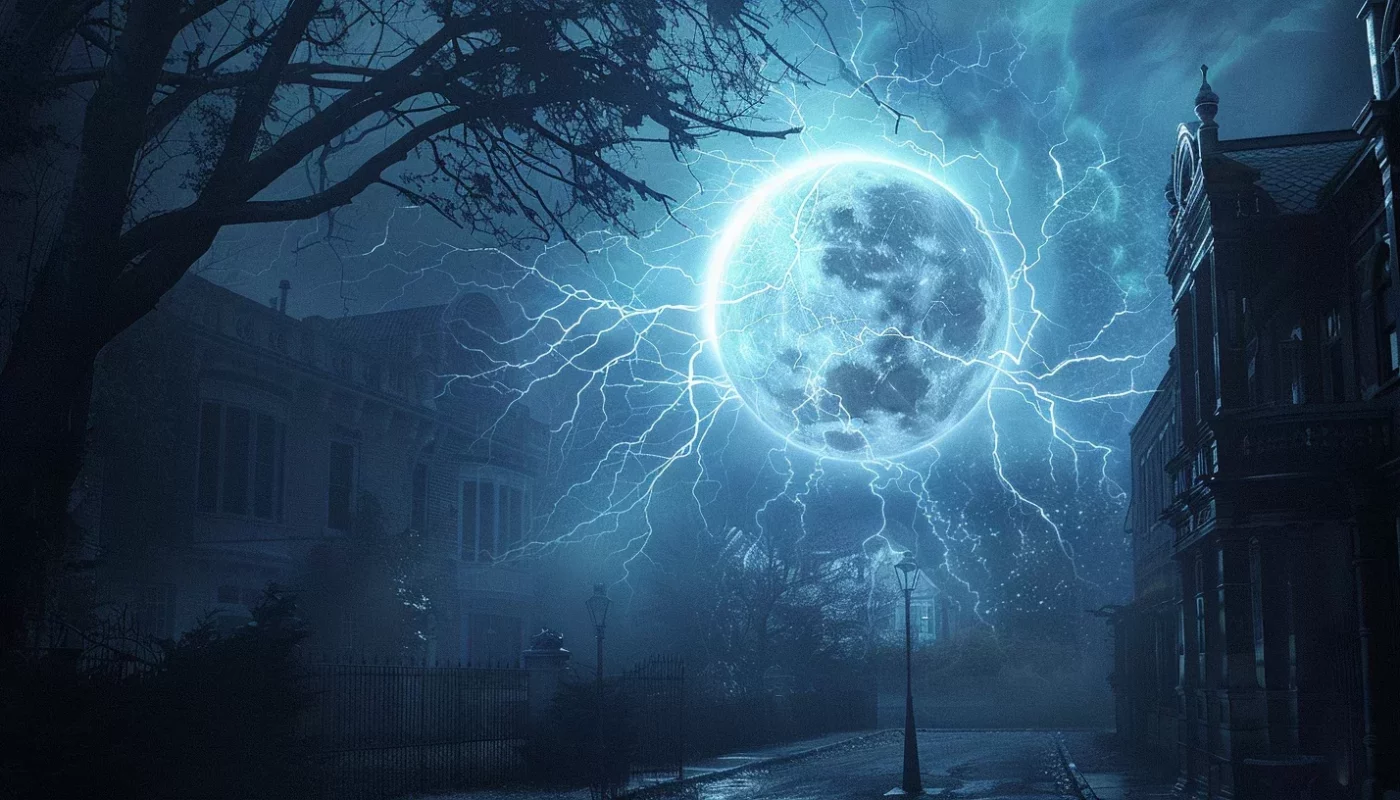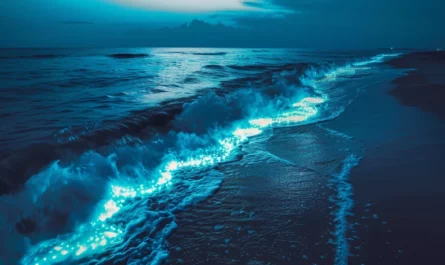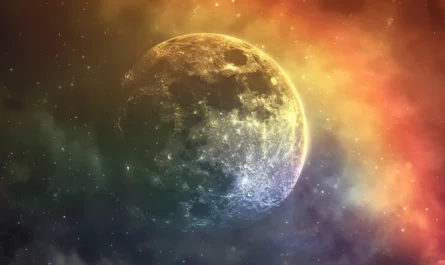Did you know ball lightning has puzzled scientists and sparked curiosity for centuries?
Ball lightning appears as glowing, round objects. They can be as small as peas or as big as several meters. It’s often seen during thunderstorms but lasts longer than typical lightning. It’s also different from St. Elmo’s fire.
What’s really strange about ball lightning is how it moves. It can zigzag, float, or even go through walls. And it doesn’t always look the same; it comes in many colors and shapes.
Even though scientists can make something similar in labs, ball lightning’s true nature remains a mystery. It keeps drawing in those eager to crack its code. They want to figure out how it forms and acts the way it does.
Join us in exploring ball lightning. We look at old stories, scientific studies, and what they might mean for the future. Understanding this mystery is tough for scientists, but it’s crucial for our knowledge tomorrow. Let’s uncover the secrets of ball lightning together.
Characteristics of Ball Lightning
Ball lightning is both fascinating and elusive. It shows many characteristics like how it moves, its attraction to things, and its looks. Learning about these can help us understand this mystery better.
Ball lightning moves in ways that surprise us. It doesn’t follow the normal rules of physics. People have seen it move in all directions and even pass through objects without any effect. This unknown movement makes ball lightning very intriguing.
This phenomenon also has a strange pull toward objects. It’s drawn to or repelled from things like buildings and cars. When it touches something, it can melt or burn it. This can be dangerous and adds to ball lightning’s mystery.
“Ball lightning moved with incredible speed, changing its course suddenly. It seemed to be attracted to anything metallic, as we observed it converging towards our car with undeniable force.” – Eyewitness account
Ball lightning’s appearance is another curious aspect. It can appear in many colors, like red, orange, and yellow. It can look like a sphere or more like a disk. This variety makes it hard to fully understand.
Ball lightning doesn’t act the same way when it disappears. Some say it vanishes instantly without a trace. Others have seen it fade slowly or even explode. These different endings add to its mystery.
To get a better idea of what ball lightning looks like, see the image below:
In conclusion, ball lightning is a mysterious and fascinating puzzle. It has unpredictable movements, strange attractions, and looks unique. As we learn more from science, we might finally solve the mystery of ball lightning.
Historical Accounts of Ball Lightning
Ball lightning has always been a source of wonder. Stories from long ago tell of glowing orbs showing up in storms. These orbs of light would enter buildings, hit ships, and cause chaos. These stories have made ball lightning a topic of legends.
Even if some stories might be exaggerated, they still show how much people are amazed by these glowing orbs. These tales help us see the incredible and often surprising nature of ball lightning. By looking into these stories, we can learn more about this mystery.
“The sky cracked with thunder, and a blinding ball of light emerged from the dark clouds. It floated effortlessly, its radiant glow illuminating the night. As it passed over our village, we could feel the hairs on our arms stand on end.”
The stories from the past help today’s research on ball lightning. Even though scientists still have a lot to learn, these old tales give clues for new studies.
| Historical Accounts | Luminous Balls | Myths and Legends |
|---|---|---|
| Accounts of ball lightning observed centuries ago | Mysterious luminous balls appearing during thunderstorms | Becoming the subject of myths and legends |
| Reports of balls of fire entering churches and striking ships | Captivating and awe-inspiring phenomenon | Stories woven into folklore, adding intrigue |
| Insights into the long-standing fascination with ball lightning | Unpredictable and often elusive nature | Inspiration for further research and exploration |
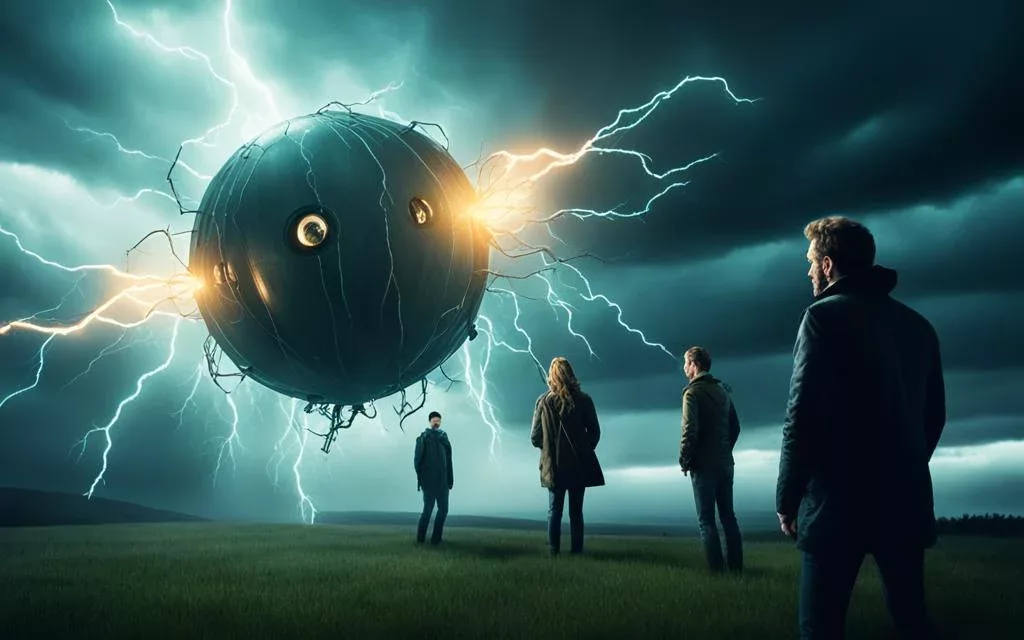
Looking at these stories carefully helps experts tell real facts from myths. The true nature of ball lightning still puzzles us. Yet, these ancient stories spark curiosity and push for serious scientific study.
Scientific Investigations
Scientists have put in a lot of work to understand ball lightning. They’ve done many studies to learn about how it forms, what it looks like, and how it acts.
Ball lightning has really gotten researchers interested in figuring it out. They’ve found clues about how it might happen, leading to new ideas to explore.
There’s a theory that ball lightning comes from certain reactions. These reactions happen when lightning hits the ground and mixes with elements around. The role of plasma is also being studied in how ball lightning is formed and behaves. But, ball lightning’s true origin and nature still puzzle us.
Researchers are trying to recreate ball lightning in labs to understand it better. They make plasma with lightning-like sparks and create plasma balls. They’re also looking at how magnetic fields affect ball lightning.
Images of Ball Lightning
An image here shows a rare look at ball lightning:
This image lets us see the glowing, round look of ball lightning. It gives us a glimpse into why this phenomenon captures our interest.
Even though we’ve learned a lot from studies, ball lightning still remains largely a mystery. Yet, scientists keep on with their quest to uncover more about this intriguing natural event.
Possible Explanations for Ball Lightning
There are several theories about ball lightning. These ideas help us understand its unique features and behaviors. But we need more research to prove these theories right.
Plasma Generated by Ground Strikes: One idea is that ball lightning comes from plasma. This plasma is made when lightning strikes the ground and reacts with certain elements around it. The energy from the lightning could create highly charged gas, leading to ball lightning.
Encapsulated Microwave Radiation from Lightning Strikes: Another theory is that ball lightning could be microwave radiation trapped in a sphere. This might happen when a lightning strike’s electromagnetic energy gets caught, creating a ball of energy.
These theories suggest how ball lightning might form. They talk about plasma, ground strikes, and microwave radiation. But, we still don’t fully understand ball lightning. More studies are needed to really figure it out.
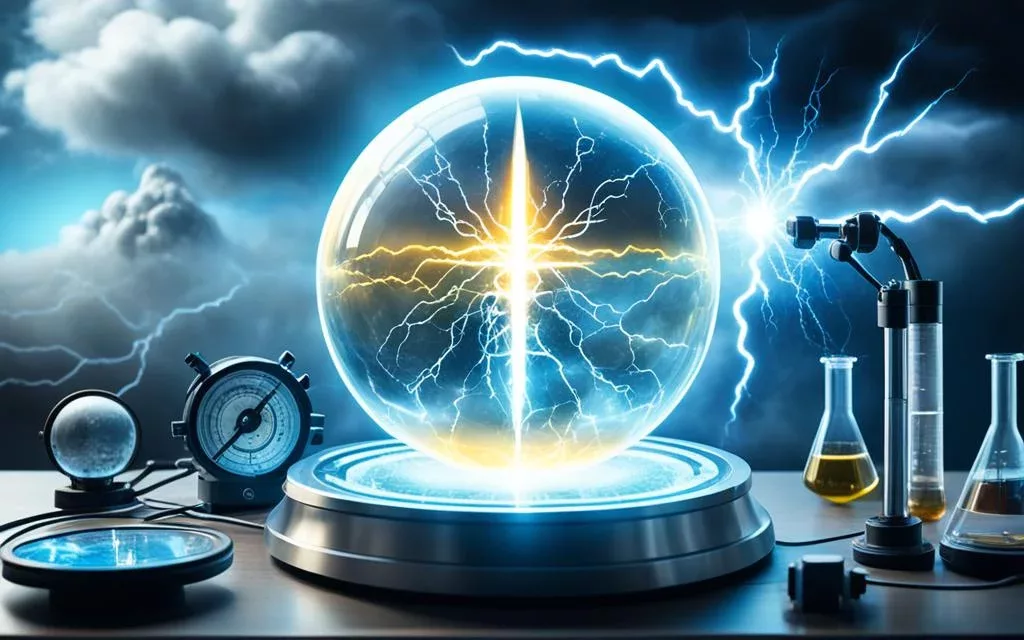
Scientists are looking into these theories to better understand ball lightning. They’re using new technology, like fast cameras and spectroscopy, to study it. With each discovery, we’re getting closer to solving the mystery of ball lightning.
Replication and Laboratory Experiments
Scientists have conducted many lab experiments to study ball lightning. They aim to replicate its properties by creating lightning-like discharges. This work helps understand this fascinating natural event better.
The main focus is on creating plasma, which is crucial for ball lightning. Plasma is a hot, charged gas with unique properties. By making plasma in labs, scientists learn more about ball lightning.
Another area of study is how magnetic fields affect ball lightning. These fields interact with charged particles, affecting plasma’s movement. This research could reveal how ball lightning forms.
While labs have advanced our knowledge, replicating natural ball lightning is hard. The unpredictable nature of the real thing makes it a challenge. But, these efforts have opened new research paths. They bring us closer to solving the mysteries of ball lightning.
Comparison of Laboratory-Generated Ball Lightning Characteristics
| Aspect | Laboratory Experiments | Natural Ball Lightning |
|---|---|---|
| Movement Patterns | Varied and controlled | Unpredictable and erratic |
| Duration | Shorter durations observed | Prolonged durations reported |
| Color | Possibility of reproducing a range of colors | Varied colors reported |
| Size | Smaller sizes observed | Wide range of sizes reported |
| Interaction with Objects | Controlled attraction or repulsion | Reports of passing through objects or causing damage |
Table: A comparison between laboratory-generated ball lightning and natural ball lightning characteristics.
Observational Evidence
Observational evidence is key when studying ball lightning. It gives us firsthand stories of this rare event. People who have seen it tell us what it looks like, how it acts, and how long it lasts. One important source comes from pilots. They have seen ball lightning in aircraft cockpits.
These pilots say they’ve seen glowing balls moving in strange ways. They often hear a buzzing or crackling too. This helps us learn a lot about ball lightning.
Not just pilots, but also people in thunderstorms have seen ball lightning. They describe glowing orbs in many colors like white, yellow, red, and blue. These orbs can hover or move strangely, even going through walls without harm. How long they last changes, from a few seconds to minutes.
“I was flying at an altitude of 35,000 feet when I saw a ball of light suddenly appear in front of the windshield. It seemed to float, moving by itself. The ball had a soft glow and a faint halo around it. Its beauty and mystery captivated me.”
While these stories tell us a lot, they are personal and can be misunderstood. That’s why we need to study these sightings more with science. This way, we can really understand ball lightning.
Connection to Other Natural Phenomena
Ball lightning is a fascinating mystery linked to other natural events like earthquakes and red sprites. It’s not fully understood yet. Some people report seeing ball lightning when an earthquake happens. Scientists are looking into how these natural wonders are connected.
Ball lightning and red sprites, atmospheric lights above thunderstorms, share luminous qualities. They are both interesting for scientists to study. Finding out how ball lightning and red sprites are alike could help us learn more about these mysterious events.
“The association between ball lightning and earthquakes offers an intriguing avenue for further research into the interconnectedness of these phenomena and their underlying causes.”
Investigating the Connections
Researchers are digging into how ball lightning could be linked to earthquakes. They think that the earth’s shakes might create electromagnetic changes that cause ball lightning. Witnesses seeing ball lightning during earthquakes back up this idea for more exploration.
The similarities between ball lightning and red sprites have also sparked interest. Scientists want to know if they share the same causes or conditions. Understanding these links could tell us more about the physics behind ball lightning and red sprites.
The Significance of Researching Connections
Looking into how ball lightning, earthquakes, and red sprites are connected is crucial. It helps us get to know the complex ways different natural events affect each other. Learning about these can reveal a lot about Earth’s atmosphere and geology.
Researching these connections can also be useful in real life. For instance, knowing more about ball lightning could improve how we protect against lightning. It might even help predict earthquakes better. So, studying these phenomena is not just interesting—it can also help people stay safer.
Challenges in Studying Ball Lightning
Studying ball lightning is hard for scientists because it doesn’t happen often and is hard to catch. It’s very challenging to study this strange and rare event in places we can control. This makes it tough to make progress in research.
People who have seen ball lightning help, but their stories can be different and not always accurate. The way they describe ball lightning varies, making it hard to know its true features and how it acts.
Also, it’s very hard to make ball lightning happen on purpose for study. The right mix of weather, electric shocks, and other things is tough to get just right in a lab.
Moreover, we don’t fully understand what ball lightning really is yet. Many ideas have been suggested, but none are agreed upon by everyone.
To move forward, we need to keep trying and studying ball lightning in new ways. Scientists have to get better at making it in labs and should work together across different fields. This teamwork could help us finally understand this mysterious light show in the sky.
Future Research Directions
The journey to understand ball lightning is full of mystery. Looking ahead, research is our tool to dive deeper into this fascinating topic. Scientists are ready to use new technologies and work together to learn more.
Conducting Laboratory Experiments
Future studies may focus on experiments in labs to mimic ball lightning. Doing so lets scientists closely examine its traits and behaviors. This work could reveal how ball lightning really works.
Utilizing Advanced Technologies
New tech brings exciting chances to study ball lightning more closely. Using fast cameras and special analysis techniques, researchers can collect detailed information. This helps us understand its size, shape, and how it moves.
Promoting Collaboration Among Scientific Disciplines
To know more about ball lightning, scientists from different fields should work together. Mixing knowledge from, for example, weather science and engineering, could open new doors. This teamwork can lead to groundbreaking discoveries about ball lightning.
“Future research on ball lightning should focus on advancing scientific knowledge and understanding of this mysterious phenomenon.”
Studying ball lightning is an exciting promise for science. Through lab work, new tech, and teamwork, we can uncover its secrets. These efforts will explain more about our world and the mysteries within it. With every new finding, we get closer to solving the puzzle of ball lightning.
Conservation and Preservation
Even though ball lightning doesn’t need saving, it’s important to keep records and stories about it. Protecting these helps future scientists learn and explore further. This is key to advancing our grasp of amazing phenomena like ball lightning.
We must keep exploring and revealing ball lightning’s secrets. This effort will lead to new discoveries and deepen our knowledge of the planet we call home.
Conservation and Preservation
Ball lightning doesn’t need specific conservation, but saving natural events like it is key for study and understanding. Keeping historical accounts and eyewitness stories helps future scientists. This lets them dig into this fascinating event’s mysteries more deeply.
We need to save and store records of ball lightning. Such efforts let scientists find patterns and improve theories. They gain better insights into what ball lightning is and how it behaves.
Knowing how ball lightning acts helps create better lightning safety systems. This can lessen the damage from lightning strikes and keep buildings and people safe.
It’s vital to keep scientific research on ball lightning going. With continuous study and tests, we learn more. This might be through lab experiments or by studying theories more closely.
Talking about saving efforts, it’s important to keep and care for lightning protection systems. They prevent damage and loss from lightning strikes. These systems give lightning a path to the ground, lowering risks of damage and injury.
| Statistics: | |
|---|---|
| Annual building damage from lightning strikes: | Up to $1 billion |
| Percentage of insurance claims attributed to lightning strikes: | 5% |
| Lightning causes nearly one-third of all church-building fires each year. | |
| The damage from lightning strikes can reach up to 50,000°F. |
Today’s lightning rods, much smaller than the old six-foot ones, bring better protection. For very tall buildings, over 75 feet, we use thicker cables to handle lightning’s power.
In protecting against lightning, don’t forget grounding systems. They are long rods, over 10 feet deep in the ground. They’re made from materials like copper to effectively ground the electrical charge.
By saving historical records, continuing research, and maintaining protection systems, we help understand ball lightning better. This supports science and keeps our natural world’s wonders alive for the future.
Conclusion
Ball lightning has always intrigued both scientists and the public. It’s a mystery that’s been around for centuries. Scientific studies shed some light on it. But, we still have many unanswered questions about ball lightning.
Researchers keep digging into ball lightning, driven by their curiosity. They want to uncover its secrets. With better technology and science, we’re getting closer to understanding ball lightning.
It’s important to keep historical and scientific data on ball lightning for the future. This information helps us learn more. By studying ball lightning, we can understand nature better.

